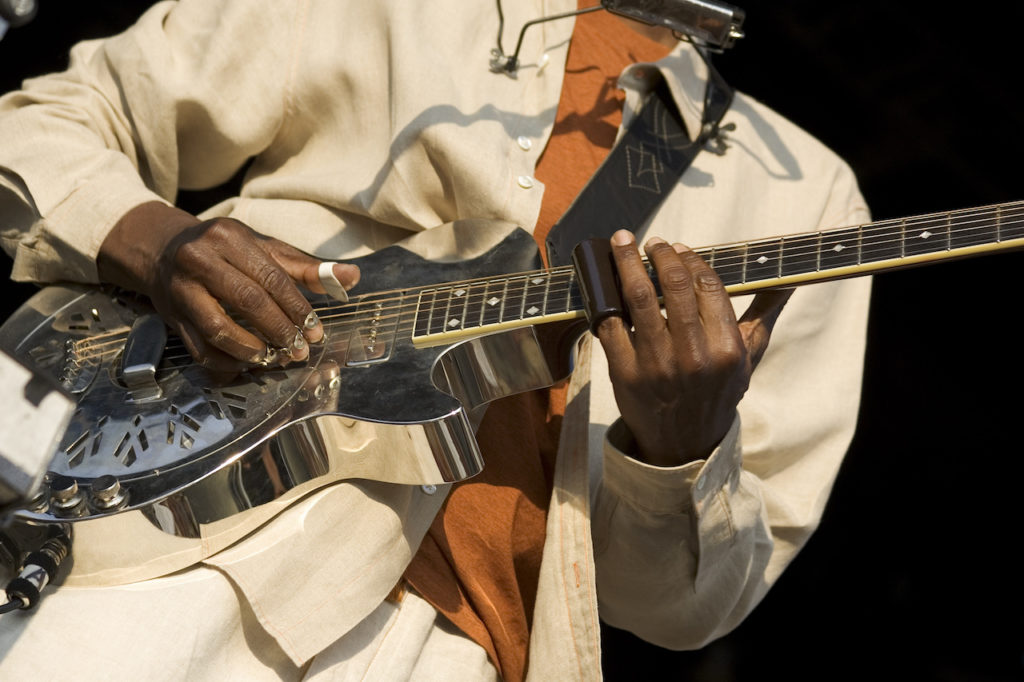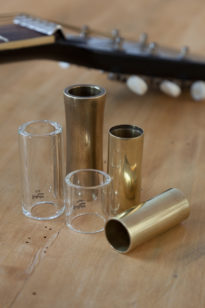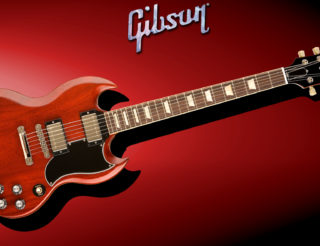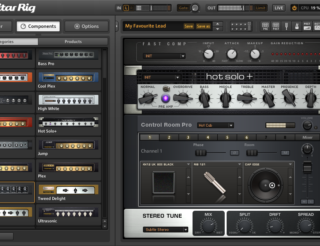Guitar Slides – An introduction for Guitar Beginners
Author: Lucas Frost

A slide is just a small tube that slips onto your finger, usually the pinky or ring-finger. Considering it is such a simple object, it’s amazing to think of how much it can change your sound, increase the diversity of your expression and even help you to approach your familiar slide guitar in a new and stimulating manner. As you will hear, there is a hell-of-a-lot you can do with one of these little tubes, and they can sound beautiful! (Perhaps the glissandos remind us more of the fluidity of the human voice and stir some deep, passionate instinct in us to cry out.)
Glissando (noun): a continuous glide between two notes
So how does it work?
The slide “cuts” the string at the point of contact, shortening it and altering the pitch – think of it as a hand-held fret. Essentially you are playing a simple bar chord, and for that reason it makes most sense to play slide with open tunings. All of this has several implications for the end result:
1) Vibrating and sliding:
BB King’s signature bends and vibratos apparently were trying to emulate slide guitar. Once mastered, playing with a slide will get you quivering and shaking those notes like a banshee on acid. Or like Muddy Waters.
2) Sympathetic vibrations:
These behave differently when you play slide guitar. First of all, the open tuning places strings in a different harmonic relationship with one another, and they “excite” each other along a different, more harmonious pattern. Furthermore, a slide allows the “headstock-side” section of the string to vibrate too, albeit discreetly. Nonetheless, this extra vibration will subtly enhance the tone you get, by enriching the overtones that reach your ear or by influencing the main strings’ vibration.
3) Creativity:
Open tunings give you not only a different timbre, but also the notes are no longer in their habitual positions. You end up with new melodies by “accidentally” playing unexpected note, and this re-arrangement lets you explore the fretboard anew, stimulating creativity.
4) Microtones:
As you are not limited to the pre-defined notes imposed by the fixed position of the frets, a slide allows a more nuanced use of microtones: that is, the pitches between frets. Derek Trucks uses this to weave Qawwali melodies into his playing, superimposing a whole range of new modalities onto his more bluesy style.
Once you get the feel for your slide and become acquainted with the tuning, it’s time to focus more on what your fingers are doing. Because the slide touches all the strings at once, these additional strings vibrate along, often rather loudly. Although this can sound pretty cool at times, you will soon want to mute these unintended strings for a tighter, more controlled result. You can do this with your right hand, either with the edge of your hand or your thumb (Derek Trucks provides a good example in this groovy piece). This is also why most slide players tend to prefer fingerpicking techniques, often an unusual mixture of using thumb and fingers in tandem depending on the desired intensity and control. Others, like Johnny Winter, even uses a thumb-pick, but this is fairly rare.
To mute the strings, you can also use the index finger of your left hand (if your slide is on the ring finger, your index finger is in a good position to gently press over the strings to mute them). This will also accustom you to using the slide and your other fingers at the same time. Slides are limiting in the sense that you only play one fret position at a time; by integrating your fingers into the technique it adds a lot more fluidity and flexibility into your melodic repertoire – the best of both worlds.
Getting the right slide for you

Material: Glass
Glass is commonly used, its warm, smooth tone making it popular with acoustic guitarists, country musicians and for the sweet, ethereal tones that elevate music towards heaven. Placed more in the background of a song, this ringing, eerie effect goes well with a nice Hammond organ or string pads to add that celestial dimension. Pair a slide with a volume pedal to emulate a lap steel guitars. Here’s an example from Tom Petty and the Heartbreakers.
But glass can also be nasty. In combination with a humbucking guitar and some creamy overdrive you have the classic Duane Allman sound: dirty, sweet and sticky. Duane began playing slide by when he had the idea of using a bottle of Coricidin pills on his finger; the long slender bottle of medicine was left at outside his door by his brother Gregg, along with a Taj Mahal album. The rest is of course history, and Coricidin bottles are still imbued with mysticism today among slide players.
Material: Metal
Metal slides on the other hand have a sharper, gnarlier sound. Think of Muddy Waters and his wild-swarm-of-bees tone. Blues players love them, often pairing them with some light overdrive to evoke the sound of a dying bat’s final screech. Broadly-speaking you have brass and stainless steel; the latter is lighter and brighter, while brass has a bit more depth to it.
Metal has the obvious benefit of not breaking very easily, allowing you to do the cool thing of carrying your slide around with you everywhere and whipping it out as and when you need. Another cool thing is that metal slides “age”. After a while, the surface will be covered in minuscule scratches and dents (particularly if you carry it in your pocket with your keys). These imperfections give colour and character to your playing.
Or want something special? Then why not make one yourself? Take a wine-bottle, carefully break off the neck and file off the sharp edges off with sanding paper, and boom – you have yourself an authentic bottle-neck slide. The imperfection at the seam, which has a slight burr, adds a certain charm to your playing in a similar way to the scratches in metal slides; it adds some grit. However, please don’t sue me if you cut yourself!
Size
There are also different sizes, both in terms of length, the thickness of the wall and in the diameter of the hole – it should fit your finger perfectly, allowing for a bend at the second knuckle. The right fit is pretty crucial: a loose-fitting slide slips off your fingers, rattles around annoyingly and just generally gets in the way of your other fingers, who are severely impeded from doing their cool embellishments ’cause they have to constantly readjust the slide. Trust me, getting it to fit nice and snuggly is your first step to enjoying and mastering slide guitar.
The length will also matter, and influences how much you can bend your knuckle. The thickness of the walls (along with the material) codetermines the weight, which affects the playability. Heavier slides glide more smoothly over the strings; but they slow you down a little and increase fatigue, obviously. But this can be advantageous: Blues legend Bonnie Raitt for example takes her time, sliding slowly into her notes, thus adding a bluesy ambiguity to her melodies. Her “lazy” slide playing also is perfect for adding texture, lying somewhere between traditional “rhythm” and “lead” roles and filling space between her vocal lines. Interestingly, she also wears the slide on her middle (2nd) finger.
In the end however, all of this is just a guideline. You will have very personal preferences, depending on your playing style as well as your finger shape/size. Just take the time to try out a couple of different ones in a good music shop (mind you, not many music shops have a wide selection of slides), pick the one that feels best and come back after you have done a bit of sliding to compare again. Hope you have fun!








Thanks for the awesome detailed review. This is great article.